<Online Exhibition>The Birth of Hiroshima、Peace Memorial City PART2
4. The Atomic Bombing
At 8:15 am on August 6, 1945, a single atomic bomb was dropped on Hiroshima and exploded about 600 meters above Shima Hospital in Saiku-machi (current Ote-machi 1-chome).
Intense heat rays were emitted from a fireball that appeared 1/10,000th of a second after the explosion, and the ground temperature at the hypocenter reached 3-4,000 °C. Those with exposed skin as far as 3.5 kilometers away were burned by these heat rays.
At its highest, the wind pressure from the blast wind was 35 tons per m2 at the hypocenter, and the wind speed was estimated to be 440 meters per second, destroying nearly all the buildings in 1.8-kilometer radius.
Of the approximately 45,000 buildings in a 2-kilometer radius, nearly all of them were completely destroyed and burnt out. About 90% of the buildings in the city were damaged, and the complete area of land lost to fires spanned 13 square kilometer.
The massive amount of radiation released during nuclear fission, mainly neutrons and gamma rays, penetrated deeply into bodily tissues, destroying cells and causing severe disabilities over a prolonged period of time.
25 August 6, 1945
Following the explosion of the atomic bomb, a strange cloud billowed into the sky over Hiroshima. This picture was taken by a US military reconnaissance aircraft located approximately 45 miles south of the hypocenter.
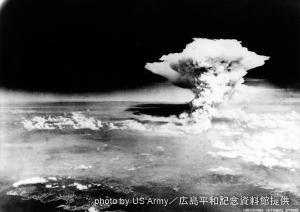
26 Hiroshima 12 Days Before the Atomic Bombing (25th July 1945)
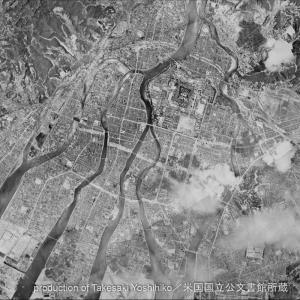
27 Hiroshima 5 Days After the Atomic Bombing (11th August 1945)
Due to the atomic bombing, buildings within and around a radius of 2 km from the hypocenter were almost completely destroyed or burned down.
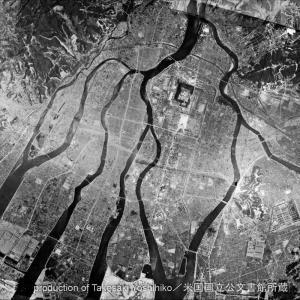
28 Hiroshima After the Atomic Bombing, the View from the Hiroshima Chamber of Commerce and Industry Building
After the atomic bombing, the view from near the hypocenter of Hiroshima was one of devastation and destruction.

29 Hiroshima Before the Atomic Bombing, the View from the Hiroshima Chamber of Commerce and Industry Building
This photograph shows the view from near the hypocenter of Hiroshima seven years before the atomic bombing.
At the time of the atomic bombing, Aioi-bashi Bridge, which was the target for the atomic bomb drop and had T-shaped, was an old wooden bridge in H-shaped.

5. Living in the Ruins
After the bombing, those who survived were in circumstances and without shelter. There were no medical supplies to treat the wounded, and even those who seemed healthy would suddenly pass away due to radiation sickness. Even after a year had passed, there was a severe food shortage as government rations were not enough, and people began to look to the black market for food.
Approximately 60% of the 36,000 students in the city had been evacuated and thus were spared from the atomic bombing. However, 75% of the 39 schools were seriously damaged: they were totally collapsed, completely burnt out, or more than halfway collapsed due to fires and the blast wind. As recovery progressed, rebuilding schools became a huge issue.
Many of the children who were evacuated outside of the city during the war lost their parents and family members in the bombing and became orphans. It is estimated that there were 5-6,000 atomic bomb orphans in Hiroshima City.
Of the survivors (hibakusha), there were many who couldn’t work very much due to illnesses and disabilities. These hibakusha faced hardships in paying for everyday expenses and medical fees. There were also many who found it difficult to work every day due to lethargy caused by the aftereffects of radiation. Until the hibakusha support system was developed, they spent decades suffering.
30 Children Living in Shacks
Survivors salvaged what materials they could from the scorched rubble and built shacks to protect themselves from the elements. Some set up housing the shells of buildings or in air-raid shelters.
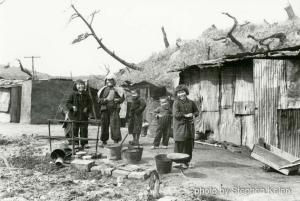
31 The Black Market in front of Hiroshima Station
After the war, a serious shortage of essential goods worsened, causing hardships in people's daily lives. An illicit black market thrived at transportation hubs such as Hiroshima Station, where limited supplies were sold at high prices, only affordable by a few wealthy individuals.
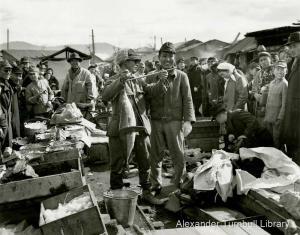
32 Black Market near Hiroshima Station, at Matsubara-cho
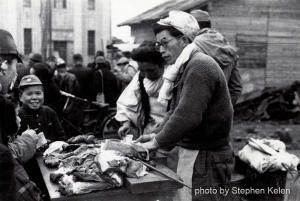
33 Open-air Classrooms (called “Aozora-kyositsu”) of Nobori-cho Elementary School in the Ruin
Most elementary school children had been evacuated when the atomic bomb was dropped, but returned to destroyed schools. They cleared the rubble with their own hands. Classes were held under the open sky without textbooks or writing pads.
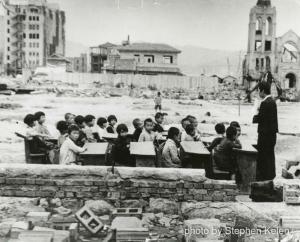
34 Norman Cousins Visiting the Hiroshima Home for War Orphans at Itsukaichi Town
In 1949 Norman Cousins, editor of the U.S.’s Saturday Review of Literature, put forward the Moral Adoption Program for aiding the atomic bomb orphans. Under U.S. law at that time, it was prohibited to adopt Japanese children, and so the Moral Adoption Program had Americans assume the role of "moral parents" to atomic-bomb orphans, assisting them with their living expenses and academic fees, and exchanging letters and presents with them. Some 600 atomic-bomb orphans are said to have received assistance in this way.
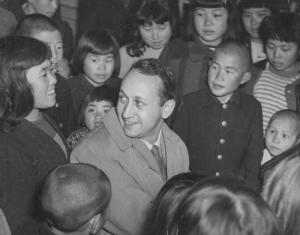
35 Children Playing Under the Peace Memorial Museum in Course of Construction
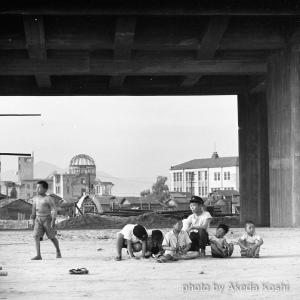
36 Physical Examination of Atomic Bomb Survivors
In 1954 a fishing boat, the 5th Fukuryu-maru, was exposed to radioactive fallout from a hydrogen bomb test. The Bikini Incident, as it came to be known, greatly strengthened efforts among the Japanese to ban atomic and hydrogen bombs, simultaneously enhancing public understanding of the need to offer special assistance to A-bomb survivors.
The Atomic Bomb Survivors Medical Care Low was enacted in 1957. Physical examinations of atomic bomb survivors were systematized by this law.
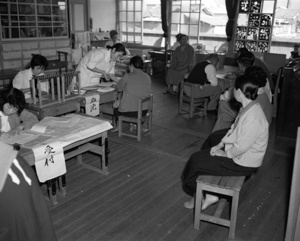
<Online Exhibition> The Birth of Hiroshima, Peace Memorial City
- <Online Exhibition>The Birth of Hiroshima, Peace Memorial City PART1
- <Online Exhibition>The Birth of Hiroshima、Peace Memorial City PART3
- <Online Exhibition> The Birth of Hiroshima、Peace Memorial City PART4
- <Online Exhibition>The Birth of Hiroshima、Peace Memorial City (Top Page)
Contact us if you would like to ask about images.
Contact Information
Hiroshima Municipal Archives
4-1-1 Ote-machi, Naka-ku, Hiroshima City, Japan 730-0051
Facsimile:082-542-8831
e-mail:[email protected]
このページに関するお問い合わせ
企画総務局 公文書館歴史情報係
〒730-0051 広島市中区大手町四丁目1番1号大手町平和ビル 6~8階
電話:082-243-2583(歴史情報係) ファクス:082-542-8831
[email protected]
